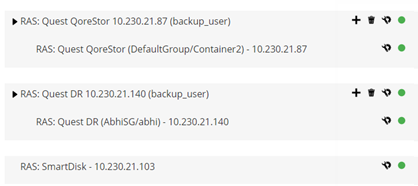Migrating savesets and backup jobs
|
a |
In the Navigation pane, click Manage Devices. |
|
b |
On the Manage Devices page, note the status of the NetVault SmartDisk device and the QoreStor device. |
|
a |
In the Navigation pane, click Explore Storage. |
|
b |
|
c |
On the Explore Disk Storage page, select the applicable device in the repository table, and click Explore Repository. |
|
d |
|
e |
|
4 |
When you are ready to start the migration process, click Manage Devices in the Navigation pane. |
|
5 |
|
6 |
|
7 |
In the Select target device dialog box, select the QoreStor device to which you want to migrate the NetVault SmartDisk saveset. |
|
9 |
To monitor the progress of the migration, click Check logs. |
The View logs page displays all NetVault Backup logs. To view only the NetVault SmartDisk, enter NVSD in the text box. The process is displayed as a percentage of the savesets that have been migrated.
EMC Data Domain Systems
This section includes the following topics:
About EMC Data Domain Systems
The DD Boost software includes two components:
|
• |
DD Boost Library: This component runs on the NetVault Backup Server, and provides the interface to communicate with the DD Boost Server running on the Data Domain system. |
|
• |
DD Boost Server: This component runs on the Data Domain systems. |
DD Boost offers the following features:
|
• |
Distributed segment processing: DD Boost offloads parts of the deduplication process to the backup client or server, enabling the client or server to send only unique data segments to the Data Domain system. |
|
• |
Advanced load balancing and link failover: This feature lets you combine multiple Ethernet links into a group, and register a single interface with the backup application. The Data Domain system automatically balances the load for backup and restore jobs on multiple interfaces, and routes the jobs to the available interfaces if one of the interfaces in the group goes down. |
|
• |
File replication: File-level replication enables transfer of deduplicated data directly between two or more DD Boost-enabled Data Domain systems, and thus reduces WAN bandwidth requirement by up to 99 percent. The Data Domain systems create and transfer the duplicate copies without using any resources on the backup server. |
Data Domain System prerequisites
|
• |
Install DD Boost license on the Data Domain System: To use a Data Domain system for backups and restores, install the required DD Boost license and enable DD Boost on the Data Domain systems. |
|
• |
Create a DD Boost user account: On the Data Domain system, create a DD Boost user account that can be used to log on to the device for backups and restores. |
|
• |
Configure the required DD Boost features: On the Data Domain system, configure the features that you want to use. For more information about enabling and configuring DD Boost features, see the DD Boost section in the DD OS Administration Guide. |
|
• |
Open the required firewall ports: To perform DD Boost backups and replication across a firewall, open the following ports on the Data Domain system: |
|
• |
Install Microsoft Visual C++ 2005 SP1 Redistributable Package on Windows: Install the Microsoft Visual C++ 2005 SP1 Redistributable Package on Windows-based NetVault Backup Server. This requirement applies to all supported Windows platforms. The DD Boost library fails to load if you do not install this package on Windows. |
|
• |
Configure network time-outs: Backup and restore jobs often take a long time to complete. Although the DD Boost Library can recover from temporary network interruptions, the operating system on the data protection application system might terminate a job prematurely if the data protection application time-outs are set too low. To avoid this, Data Domain recommends setting time-outs to at least 30 minutes (1800 seconds). |

